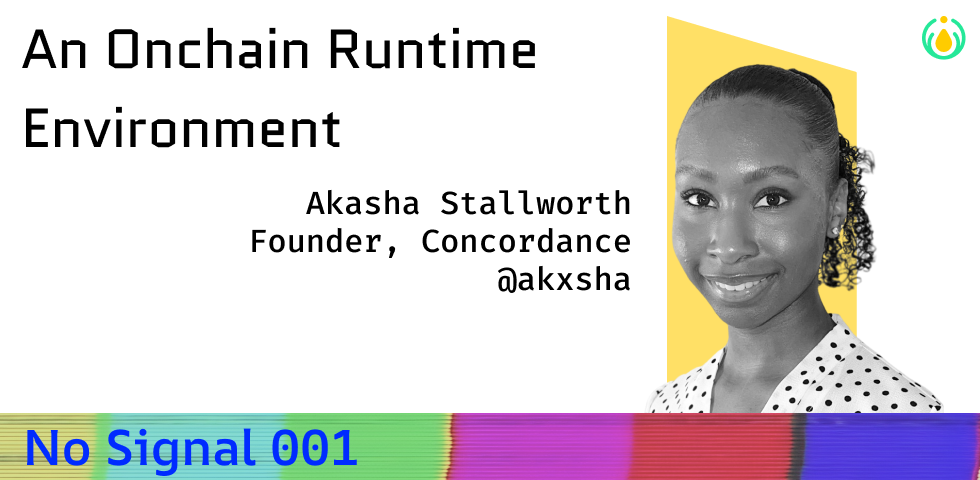

“Publicly verifiable truth means more humans can reach consensus on the basic state of their shared realities and get on transacting in increasingly valuable ways based on new kinds and degrees of trust.” Kernel Module 1, Trust
Crypto is riddled with jargon. It demands so much of the end user – get a wallet, pay for gas, learn what an NFT is – that few choose to sacrifice the well-worn comforts of a centralized platform for the promise of a decentralized future.
Akasha Stallworth (KBX) believes that’s a symptom of an unnecessarily complex developer environment. “The end user has to have so much knowledge and context because the developer experience is poor,” she told Kernel. “You wanna just open up an app and listen to music. And if a developer can simply encode that, that experience gets directly transferred to the end user.”
Her new project Concordance aims to unlock that reality. Imagine “a unified portal where everybody is interfacing with a fully decentralized network environment.” It’s “multi-chain, it's multi-application, it's multi-user – and all of these things are coordinating together in truly trustless environments.”
That’s the “world computer experience” Akasha is building toward. And it all starts with new degrees of trust.
Akasha's Story¶Akasha was born and raised in Northern California. “ I watched Silicon Valley creep into the Bay Area and really transform the culture,” she said. “So I've been exposed to tech for so much of my life.”
She earned her bachelor’s degree in computer science from California State University-Sacramento, and began her professional career as a data engineer at Intel. There, she worked on complex supply chain manufacturing systems and led a divestiture process that led to a new startup.
“That was a crazy process – I learned so much,” she said. “Not just the technical splitting of a legacy system, but: what does the business care about? And how do we prioritize those values and translate deeply technical things to non-technical people in a way that’s consumable?”
That background got her recruited as the youngest manager at American Express, where she shelved her developer hat to address complex business decisions about consumer data – where it’s stored, how it’s structured, who can see what.
At the time, she was watching the blockchain space passively, dabbling to keep her technical skills sharp and “waiting for the next wave of technology that would really revolutionize it.” Then zero-knowledge proofs arrived.
Businesses like American Express, she envisaged, could use zero-knowledge proofs to hide sensitive data, and the blockchain could replace third-party intermediaries that weren’t in consumers' best interests. That should be easy enough to implement, she thought. It wasn’t.
Frustrated, she began investigating why even simple web3 applications were so difficult to build. “I put in my two weeks and I went to so many conferences,” she told (me/us). “I just talked to engineers and I was like, ‘what am I missing?’”
The blockchain – ultimately, a simple state machine whose state is contained as its ledger – faces a fundamental limitation. It relies on a bevy of trusted intermediaries – oracles, bridges, indexers – to perform the complex data processes that a deterministic state machine cannot handle on its own. In other words: if you want to build an app that interacts with the blockchain, you need to trust a third party that has imposed their own rules, security risks, and fees.
“As soon as you get locked into a service, you're in their playground of what features and capabilities they enable,” Akasha explained.
“And as soon as your use case doesn't suit what they've pre-crafted, then you can't apply the technology.”
This isn't the trustless ecosystem we've been promised. The core issue, she says, is that today’s blockchain primitives can't manage the constantly changing application states (on-chain, client-side, backend) that complex applications require. It’s a fundamental departure from the client-server architecture developers are used to, and it makes complex coordination impossible.
“Right now blockchain's all about tokens, and tokens equal coins, but it's not just about coins and tokens. It's about coordination,” she said. “So let's really show this as a viable world computer for complex coordination.”
If you can manage state reliably, then you can start to build more sophisticated coordination logic – you can begin to dabble in “shared realities.” We just need to ask, as she did: “What is the primitive that we need to build real applications that run on the blockchain?”
Concordance¶Concordance is a primitive that unifies state management and enables a build experience where developers feel like they're writing server-side code. “They feel like they have a connection to the client,” she said. In essence, it brings the ease of web2 app development on-chain.
Akasha is building Concordance atop Anoma (she’s part of their builders program), a distributed operating system (OS) that abstracts technical complexity from the end user.
“You don't worry about any of that – where does this need to go? Does it need to settle on Ethereum? Do I need to make my own token on Solana? – because they’re building with ‘intents’,” Akasha said.
‘Intents’ represent what someone wants to do when using an app – like swap tokens, or buy a flight. As the Ethereum Virtual Machine (EVM) processes transactions into state changes, Anoma’s Intent Machine processes intents into state changes.
Concordance then serves as Anoma's trustless oracle layer, ensuring the data driving the intents and managing the application's state is truly decentralized, transparent, and resilient. Developers can focus on building blockchain applications that are as simple as: open app, listen to music.
It’s a beautiful vision – and an ambitious one. “ The major challenge today is getting people to understand such a fundamentally different approach to building in web3,” Akasha said. “No more protocol engineering, no more smart contract engineering. Here's a framework – you build with that framework and you deploy an application.”
It’s a sea change of heroic proportions – one that will require a dedication to the craft, and a community that can sense that same ‘open app, listen to music’ dream.
Kernel¶With that mountain in front of her, a friend encouraged Akasha to apply to Kernel. “I said ‘no, I'm too early stage to be in any sort of program – I'm just trying to figure this out.”
“He's like, ‘no, join Kernel. Trust me.”
She applied last minute and joined 105 others in Kernel’s tenth block.
“What's nice about Kernel is that it's about the person. It's not really about the project, and they were like, ‘you have a unique perspective on something that you're actively figuring out. Come and join us.’
“ It was such a beautiful experience of both technical and non-technical people noticing these same things – it gave me reassurance,” she continued. “I don't have to go this route of building a protocol. I can figure out something new and be supported by a community in that process.”
Trust begins with intent, but its “figuring out” happens in community. “Right now the priority is really proving out the fundamentals,” Akasha said, “continuing to work with the builders, continuing to work with people who are building culture and asking questions.”
It’s from that work that shared realities emerge. As the Kernel Book reminds us, “diversity is nature's response to adversity… so we should never aim for complete agreement, but rather trust the process of disagreement to enable something truly useful to emerge over time.”
Once we agree to disagree, we can figure out how to coordinate in new and complex ways, and unearth new degrees of trust. That’s how we find concordance.
For rabbit hole dwellers, we ask each featured fellow to share some deeper technical inspiration – e.g. research docs, whitepapers – that adds depth to their work.
These are Akasha’s:
Read More
 Free Learn
Free Learn A novel experiment which combines narrative encoded in a mnemonic medium with economic incentives to see if we can solve the problem of funding public tools for transformative thought.
 Constituting Consensus
Constituting Consensus Break with the paradigmatic approach to history and ensure that a shared understanding of what constitutes meaningful consensus is placed at the heart of all actions which collectively make us up.